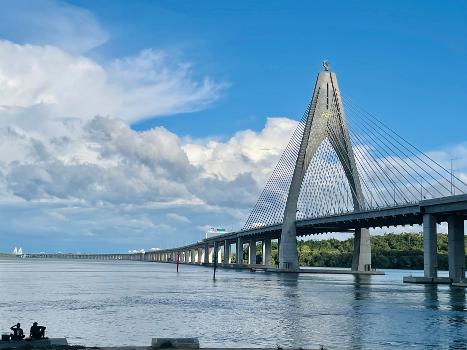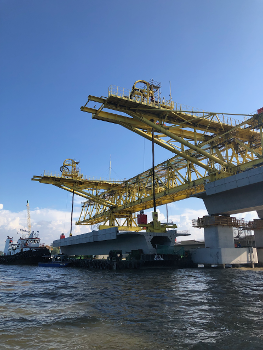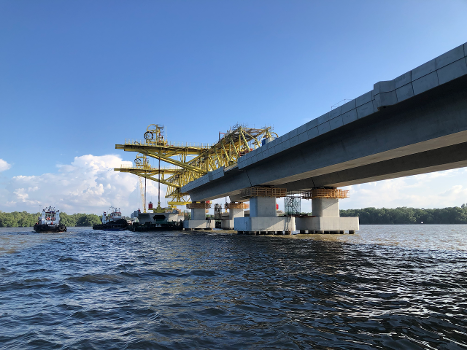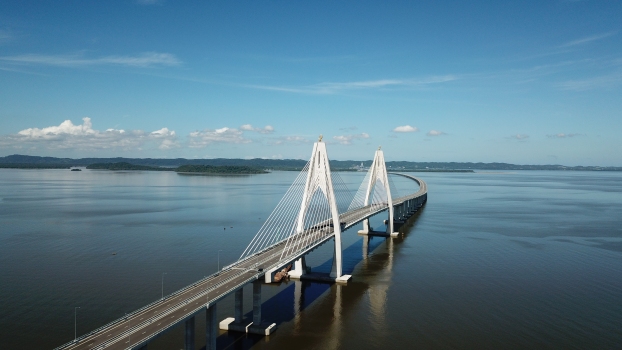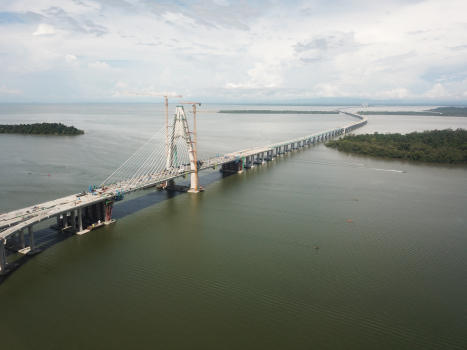General Information
| Other name(s): | Temburong Bridge |
|---|---|
| Beginning of works: | Mid of 2014 |
| Completion: | 17 March 2020 |
| Status: | in use |
Project Type
| Function / usage: |
Divided highway / dual carriageway |
|---|
Location
| km | Name |
Technical Information
Dimensions
| total length | 30 km |
Excerpt from Wikipedia
Sultan Haji Omar Ali Saifuddien Bridge (Malay:Jambatan Sultan Haji Omar Ali Saifuddien, Jawi: جمبتن تمبوروڠ) is a dual-carriageway bridge in Brunei. It is the longest bridge in Southeast Asia, 30-kilometre (19-mile) long. It connects Mengkubau and Sungai Besar in Brunei-Muara District with Labu Estate in Temburong District. This is the first road bridge in the country that directly links the mainland with the Temburong exclave, which are physically separated by the Sarawakian district of Limbang in Malaysia and Brunei Bay in the South China Sea. The bridge allows commuters to travel between the two territories without having to go through Malaysia, hence bypassing the four immigration checkpoints along the current route, which is frequently congested. The bridge also improves mobility of Temburong residents to reach other parts of Brunei, especially the capital, Bandar Seri Begawan, shortening travel times. Previously, the only direct connection between the capital and Bangar, the district town, was via water taxi services, which took about 45 minutes.
Construction on the bridge started in 2014 and was expected to be completed and opened by the end of 2019, but it ultimately opened during March 2020. The bridge was built by both Daelim, a South Korean company, and China State Construction Engineering Corporation (CSCEC), a Chinese state-owned company. The project is reported to cost 1.6 billion Brunei dollars (US$1.2 billion as of March 2018).
Due to the COVID-19 pandemic, the bridge was opened ahead of schedule on 17 March 2020, a day after Brunei barred most non-resident foreigners from entering the country, and most citizens and residents from leaving, which would have otherwise disconnected Temburong from the rest of the country.
On 14 July 2020, in conjunction of Sultan Haji Hassanal Bolkiah's 74th birthday, the bridge was named Sultan Haji Omar Ali Saifuddien Bridge in honor of the Sultan's late father, Sultan Haji Omar Ali Saifuddien Saadul Khairi Waddien was regarded as the Architect of Modern Brunei.
Construction
The construction of the bridge was divided into six 'packages' or contracts. The first was CC1 or the Mentiri Tunnels which involved the construction of a series of tunnels through the Mentiri Ridges which connects Jalan Utama Mentiri, a controlled-access dual carriageway, with Jalan Kota Batu. Other construction packages included CC2, CC3 and CC4 comprising Marine Viaducts, Navigation Bridges and Temburong Viaduct respectively. CC2 and CC3 were awarded to Daelim, a South Korean company, which was responsible for constructing a system of viaducts and two cable-stayed bridges that crosses the Brunei Bay. Meanwhile, China State Construction Engineering was awarded the CC4 contract and was responsible for constructing the land viaduct which traverses the mangrove swamp of Labu Forest Reserve. CC5A and CC5B are the traffic control and survelliance system, and power supply system respectively.
Route
The road system is a controlled-access dual carriageway which begins at a grade-separated interchange with Jalan Utama Mentiri between the Sungai Akar roundabout and the Salambigar intersection. The road then goes through two parallel tunnels and ends at another grade-separated interchange with Jalan Kota Batu. This section is 3.6 kilometres (2.2 miles) long. The bridge then begins, with a 14.5-kilometre (9.0-mile) viaduct across the Brunei Bay, passing across the tip of Pulau Berambang, then in between Pulau Pepatan and Pulau Baru-Baru, up to Tanjung Kulat in Temburong. Finally, another 11.8-kilometre (7.3-mile) viaduct begins from Tanjung Kulat and ends at Jalan Labu, traversing through Labu Forest Reserve, and includes a bridge which crosses the Labu River, before intersecting with Jalan Labu at a roundabout.
Text imported from Wikipedia article "Temburong Bridge" and modified on September 14, 2020 according to the CC-BY-SA 4.0 International license.
Participants
Relevant Web Sites
Relevant Publications
- (2018): Brunei Temburong Link. Presented at: IABSE Conference: Engineering the Developing World, Kuala Lumpur, Malaysia, 25-27 April 2018, pp. 47-53.
- (2023): Feasibility Study, Detailed Design and Construction of the 27km Brunei Temburong Bridge. In: Proceedings of the Institution of Civil Engineers - Bridge Engineering, v. 176, n. 3 (September 2023), pp. 1-27.
- (2023): Innovation in the design and construction of Temburong Bridge, Brunei. Presented at: IABSE Congress: Engineering for Sustainable Development, New Delhi, India, 20-22 September 2023, pp. 445-452.
- (2023): Sultan Haji Omar Ali Saifuddien Bridge (Temburong Bridge): span by span deck erection. In: Proceedings of the Institution of Civil Engineers - Bridge Engineering, v. 176, n. 3 (September 2023), pp. 1-24.
- (2015): Temburong Bridge Brunei- Aesthetic Design to Principles of MIB. Presented at: IABSE Conference: Elegance in structures, Nara, Japan, 13-15 May 2015, pp. 96-97.
- About this
data sheet - Structure-ID
20066997 - Published on:
27/04/2015 - Last updated on:
05/05/2024

